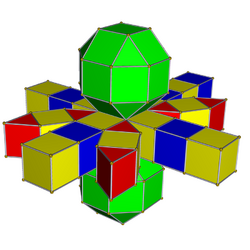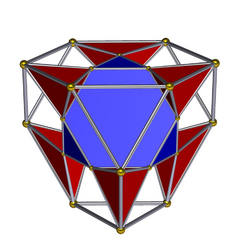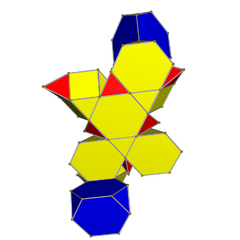Rhombicuboctahedral prism
| Rhombicuboctahedral prism | |
|---|---|
| Type | Prismatic uniform polychoron |
| Uniform index | 53 |
| Schläfli symbol | t0,2,3{3,4,2} or rr{3,4}×{} s2,3{3,4,2} or s2{3,4}×{} |
| Coxeter diagram | |
| Cells | 28 total: 2 rr{4,3} or s2{3,4} 8 {}x{3} 18 {4,3} |
| Faces | 100 total: 16 {3} 84 {4} |
| Edges | 120 |
| Vertices | 48 |
| Vertex figure |  Trapezoidal pyramid |
| Symmetry group | [4,3,2], order 96 [3+,4,2], order 48 |
| Properties | convex |
In geometry, a rhombicuboctahedral prism is a convex uniform polychoron (four-dimensional polytope).
It is one of 18 convex uniform polyhedral prisms created by using uniform prisms to connect pairs of Platonic solids or Archimedean solids in parallel hyperplanes.
Images
 Net |
 Schlegel diagram One rhombicuboctahedron and triangular prisms show |
Alternative names
- small rhombicuboctahedral prism
- (Small) rhombicuboctahedral dyadic prism (Norman W. Johnson)
- Sircope (Jonathan Bowers: for small-rhombicuboctahedral prism)
- (small) rhombicuboctahedral hyperprism
Related polytopes
Runcic snub cubic hosochoron
| Runcic snub cubic hosochoron | |
|---|---|
| Schläfli symbol | s3{2,4,3} |
| Coxeter diagram | |
| Cells | 16 total: 2 t{3,3} 6 {3,3} 20px 8 tricup |
| Faces | 52 total: 32 {3} 12{4} 8 {6} |
| Edges | 60 |
| Vertices | 24 |
| Vertex figure | 
|
| Symmetry group | [4,3,2+], order 48 |
| Properties | convex |
A related polychoron is the runcic snub cubic hosochoron, also known as a parabidiminished rectified tesseract, truncated tetrahedral alterprism, or truncated tetrahedral cupoliprism, s3{2,4,3}, ![]()
![]()
![]()
![]()
![]()
![]()
![]() . It is made from 2 truncated tetrahedra, 6 tetrahedra, and 8 triangular cupolae in the gaps, for a total of 16 cells, 52 faces, 60 edges, and 24 vertices. It is vertex-transitive, and equilateral, but not uniform, due to the cupolae. It has symmetry [2+,4,3], order 48.[1][2][3]
. It is made from 2 truncated tetrahedra, 6 tetrahedra, and 8 triangular cupolae in the gaps, for a total of 16 cells, 52 faces, 60 edges, and 24 vertices. It is vertex-transitive, and equilateral, but not uniform, due to the cupolae. It has symmetry [2+,4,3], order 48.[1][2][3]
It is related to the 16-cell in its s{2,4,3}, ![]()
![]()
![]()
![]()
![]()
![]()
![]() construction.
construction.
It can also be seen as a prismatic polytope with two parallel truncated tetrahedra in dual positions, as seen in the compound of two truncated tetrahedra. Triangular cupolae connect the triangular and hexagonal faces, and the tetrahedral connect edge-wise between.
 Projection (triangular cupolae hidden) |
 Net |
References
- ↑ Klitzing, Richard. "4D tutcup". https://bendwavy.org/klitzing/dimensions/polychora.htm.
- ↑ Category S1: Simple Scaliforms Tutcup
- ↑ http://bendwavy.org/klitzing/pdf/artConvSeg_8.pdf 4.55 truncated tetrahedron || inverse truncated tetrahedron
External links
- 6. Convex uniform prismatic polychora - Model 53, George Olshevsky.
- Klitzing, Richard. "4D uniform polytopes (polychora) x3o4x - sircope". https://bendwavy.org/klitzing/dimensions/polychora.htm.
 |

